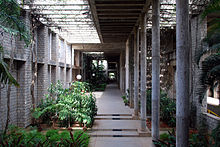Balkrishna Vithaldas Doshi
Balkrishna Vithaldas Doshi (born August 26, 1927 in Pune , Maharashtra ) is an Indian architect .
life and work

Doshi was heavily influenced by Le Corbusier , in whose office he worked in Europe in the early 1950s and in Ahmedabad from 1954 to 1957 , where he took over the construction management for four industrial villas planned by Le Corbusier, including the Sarabhai House of Vikram Sarabhai in Ahmedabad. These exerted an important influence on his first independent work, with which he began in parallel in his own architectural office Vastu-Shilpa .
His first plans were a housing estate for textile workers in Ahmedabad (1957-1960) and in 1963 the Indian Institute of Management in Bangalore . The buildings are two-story made of natural stone masonry. The monotonous gray is structured by the incidence of light, which casts shadows in the open courtyards, which are partially covered with stone beams. Frequently used Doshi barrel vaults , as in the Sangah, his own office and seat of the Vastu Shilpa Foundation (the foundation carries out research in the environmental field), completed in 1981. The white concrete shells are reminiscent of the barrel roofs of the earliest Buddhist cave monasteries or of mounds of earth. The garden is harmoniously designed with terraces, water channels and trees.
As a city planner, Doshi designed Vidyadhar Nagar, a suburb of Jaipur, from 1984 to 1986 . The city is cited as an architectural example, as it was built as a complete complex in the 18th century strictly according to the principles of Vastu Vidya. In Doshi's concept the attempt to combine a synthesis between the reformist urbanism of Le Corbusier and its emphasis on nature and sun with the tradition of courtyards and narrow streets becomes visible. He adopts the 9-field diagram of the Vastu Purusha Mandala used by his predecessor in the 18th century and reinterprets dimensions and social division through to facade design in contemporary language. In conversation he lamented the uniform architecture of modernity and missed the mythical world of prehistoric man in it. Another use of the Vastu Purusha Mandala is when it was drafted for the Computer Science and Engineering Department at the Indian Institute of Technology in Mumbai in 1994 , using the diagram in this case ritually rather than literally. Due to the inclusion of natural conditions as part of the concept, for example by using the houses themselves as shade providers or by aligning them along the course of the day of the sun, the buildings require e.g. B. no air conditioning and are therefore energetically sustainable.
In 1989, planned and built Doshi in Indore , the Aranya low cost housing , affordable condominium with 6,500 residential units in 2017 already lived more than 80,000 people. The apartments range from simple rooms to generously dimensioned and luxuriously furnished rooms. When asked about his motivation to achieve buildings for people who can seize them, his answer is “If you are not in awe, then you don't even need to build”.
In 2007 Doshi received the Global Award for Sustainable Architecture . In March 2018 he was awarded the Pritzker Prize . The jury justified its decision as follows: Doshi had a "deep sense of responsibility and the desire to make a contribution to his country and its people through authentic architecture of the highest quality".
He has lived in Ahmedabad since the 1950s.
Web links
- Balkrishna Doshi - architecture for people. Retrospective at the Vitra Design Museum , 2019.
- Talk with Balkrishna Doshi in the NZZ on the occasion of the 2019 retrospective.
- Balkrishna Vithaldas Doshi. In: arch INFORM .
- Balkrishna Doshi. Collection of articles at Dezeen.
Individual evidence
- ^ Vikram Bhatt, Peter Scriver: After the Masters. Contemporary Indian Architecture. Mapin Publishing, Ahmedabad 1990, pp. 64-67.
- ↑ Ashish Nangia: Postcolonial India and Its Architecture II: Balkrishna Doshi V - The Mythical and the Modern. Bolojii.com. Retrieved April 17, 2019.
- ^ Doshi in: William Curtis: Balkrishna Doshi. An Architecture for India. 1988, p. 165. From: Vibhuti Chakrabarti: Indian Architectural Theory. Contemporary Uses of Vastu Vidya. Curzon Press, Richmond 1998, p. 28, gen. P. 91.
- ↑ Philipp Löwe: Architecture of empowerment: Mr. Doshi builds a better world . In: Spiegel Online . April 17, 2019 ( spiegel.de [accessed April 24, 2019]).
- ↑ a b Pritzker Prize goes to Balkrishna Doshi. In: Tagesspiegel , March 8, 2018.
- ↑ Philipp Löwe: Architecture of empowerment: Mr. Doshi builds a better world . In: Spiegel Online . April 17, 2019 ( spiegel.de [accessed April 24, 2019]).
- ↑ Global Award for Sustainable Architecture. Cité de l'architecture et du patrimoine, accessed on June 4, 2020 (English).
- ↑ Laureates: Balkrishna Doshi. In: Website of the Pritzker Architecture Prize. Accessed March 7, 2018 (English).
- ↑ Noted architect narrates life in pols. In: The Times of India , December 18, 2010 (English).
| personal data | |
|---|---|
| SURNAME | Doshi, Balkrishna Vithaldas |
| BRIEF DESCRIPTION | Indian architect |
| DATE OF BIRTH | August 26, 1927 |
| PLACE OF BIRTH | Pune , India |


